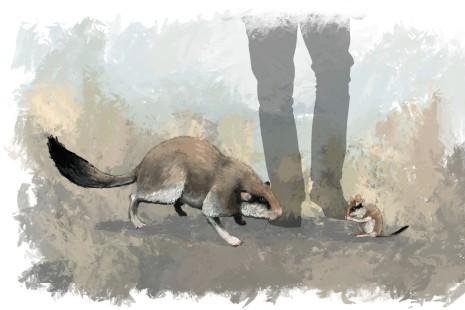An rtist's impression of the giant dormouse, at left, and its nearest living relative the garden dormouse, on the right. Photo by James Sadler/University of York
July 9 (UPI) -- A British doctoral student has reconstructed the skull of a gigantic dormouse that roamed through Sicily two million years ago.
Jesse Hennekam, a doctoral student at the British Hull York Medical School, University of York, reconstructed the giant dormouse skull by digitally piecing together fossilized fragments of five giant dormouse skulls, the university announced on Thursday.
The long-extinct rodent was the largest species of dormouse ever identified, and roughly the size of a cat, according to researcher estimates.
The skull alone was 3.9 inches long -- the length of the entire body and tail of modern types of dormouse -- researchers said, according to the study, published this month in the journal Open Quarternary.
Hennekam first saw the fossilized fragments while visiting the Palermo Museum in Italy for research.
He said he discovered the fragments in a museum display that showed a segment of rock from a small cave floor found while the motorway in northwest Sicily was being constructed in the 1970s.
"I noticed what I thought were fragments of skull from an extinct species embedded in one of the cave floor segments," Hennekam said in a statement. "We arranged for the segment to be sent to Basel, Switzerland for microCT scanning and the resulting scans revealed five fragmented skulls of giant dormice present within the rock."
After digitally merging cranial elements of various skulls, the researchers made "an accurate approximation" of the cranial shape of the dormouse, according to the study.
Ancient Sicily also had giant swans, giant owls and dwarf elephants, the researchers said.
The researchers think the composite reconstruction could play a big role in future research to understand the causes and means by which some animals on islands evolve larger body sizes.
"While island dwarfism is relatively well understood, as with limited resources on an island animals may need to shrink to survive, the causes of gigantism are less obvious," said Dr. Philip Cox, Hennekam's doctoral supervisor.
"Perhaps, with fewer terrestrial predators, larger animals are able to survive as there is less need for hiding in small spaces, or it could be a a case of co-evolution with predatory birds where rodents get bigger to make them less vulnerable to being scooped up in talons," said Cox, a researcher at the Department of Archaeology at the University of York and Hull York Medical School.















